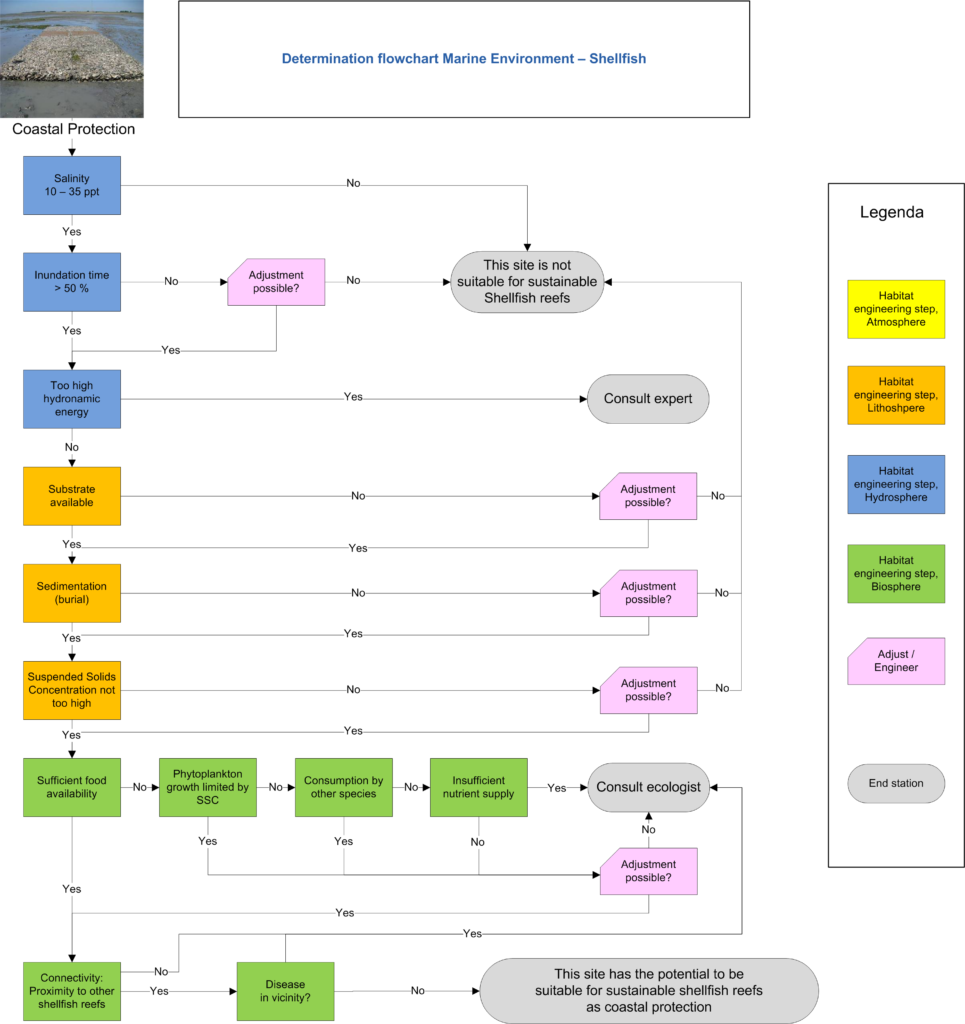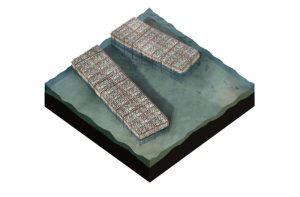How to Use
General
If an ecosystem engineer is considered to be included in a design for coastal protection or coastal rehabilitation, several questions need answering:
- Is it possible to create a suitable habitat for a specific ecosystem in the project area?
- What would be the envisaged services provided by this ecosystem?
- To what extent can the ecosystem contribute to the primary function of the design and how does this affect the design itself? For example, what dimensions of a shellfish reef are needed to reduce erosion or stabilize sediment? And what dimensions to act as an efficient wave reflector?
- What effects do the ecosystem engineers in this ecosystem have on the existing physical, ecological and socio-economical system?
- What are the costs, uncertainties and risks ensuing from including these ecosystem engineers in the design?
In this Concept, the focus lies on the habitat requirements for shellfish. The determination flowchart gives a first answer to the suitability of the project area as a habitat for shellfish. Other questions can be elaborated in subsequent or parallel steps.
Determination flowchart
The determination flowchart is based on the habitat requirements described in the general introduction. The goal of the determination flowchart is to give an easy, accessible and low-cost first indication of whether a suitable habitat for shellfish exists or can be created. The flowchart can also be employed to determine if restoring or improving existing shellfish reefs is an option, as it helps finding the possible causes of shellfish degradation or development stagnation.

The potential ecosystem services of shellfish are:
- Coastal protection, e.g. by dissipating wave energy, thus reducing erosion of the protected area
- Water quality improvement by acting as a nutrient filter, by reducing turbidity via sediment trapping, etc.
- Providing a sustainable barrier hampering sediment transport from the protected area into the adjacent channels; this barrier is able to keep up with a certain rate of (relative) sea-level rise by trapping sediments
Other ecosystem services, such as provision, cultural and supporting services are not evaluated here.
The project Shellfish reefs of Building with Nature in the Eastern Scheldt gives further details on how to use shellfish reefs for protecting tidal flats against erosion.
Current Situation
Before employing the flowchart it is important to establish which (eco)system is present in the current situation and which function(s) it holds. Creating something new always comes at the cost of what presently exists. For every type of ecosystem, like a tidal flat, coral reef, seagrass meadow or saltmarsh, it is necessary to understand that system before being able to prevent or undo its degradation. Species communities may even support each other: a coral reef, for instance, can dissipate wave energy and create a sheltered area for seagrasses. The analysis of the current system should extend beyond the project site and consider adjacent systems. One reason is that engineering works usually have a large influence on the sediment budget and hence on adjacent areas, another is that adjacent communities may produce seedlings for natural settling in the project area.
It is important to keep in mind that an existing (eco-)system may have other functions, such as cultural or supporting services, that may be lost by constructing something new. For example: creating a shellfish reef might be less attractive in a recreational area where people swim. If losing current functions is considered acceptable as long as a (new) shellfish reef providing the desired ecosystem services is created in return, the determination flowchart can be used.
The goal of the flowchart is to have a first answer to the following question:
‘Does the intended project area have potential to (re-)establish a sustainable shellfish reef which provides the desired ecosystem services?’
The flowchart aims to indicate whether the important habitat requirements which enable the establishment and sustainable presence of shellfish are naturally present or can be engineered. The result can only be a first-order indication, as the dynamics involved are too complex to comprise in a generic tool. If and when more precise information is needed in later project stages, local shellfish expertise should be called in.
Interpretation
Before employing the flowchart, several issues have to be considered. Firstly, shellfish reefs only occur in temperate environments. Secondly, the history of the proposed site can give a good indication on the suitability for creating a shellfish reef. If a reef was present in the past, but lost e.g. due to human activities, this may indicate that the environmental conditions (salinity, wave exposure etc.) are in principle suitable for creating or restoring a shellfish reef. Other causes of disappearance can give insight into the habitat requirements that need to be adjusted or created. Finally, contaminated areas will hamper shellfish establishment and growth. The possibility to remediate the water and/or soil quality should be considered first, before going through the flowchart.
When going through the flowchart, note that comments are available to interpret the provided values. Keep in mind that every location is unique and has characteristic dynamics and shellfish ecosystems are characterized by complex interactions. This makes it challenging to give precise thresholds, which explains why many habitat requirements remain to be specified.

